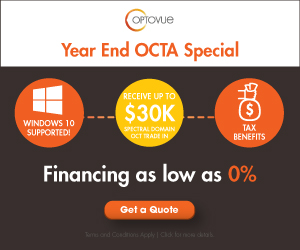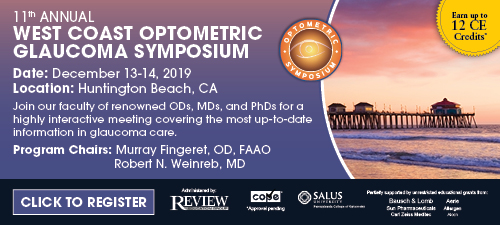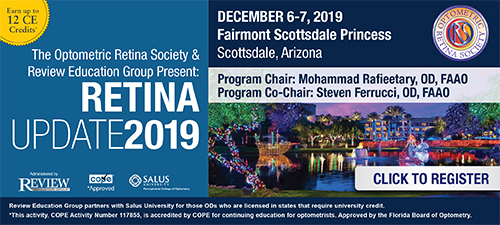
A
weekly e-journal by Art Epstein, OD, FAAO
Off the Cuff: Finding a Path Forward
A good deal of my career has been spent working closely with ophthalmologists. In NY, at the peak of my practice, we received ongoing referrals from more than 60 area ophthalmology practices for specialty contact lens care. For well over a decade, I served as a voluntary unpaid attending in the North Shore University Hospital Department of Ophthalmology. I devoted a full day a week to teaching residents and seeing patients with them. I practiced with Drs. Eric Donnenfeld and Hank Perry for many years, learning much and occasionally enlightening these brilliant clinicians and incredible human beings. Now in Phoenix, our practice is well integrated into the medical community. We have wonderful relationships with many area ophthalmology practices, receiving referrals for dry eye and referring for surgical management. We work closely with many primary care practices. A lot has changed since that failed attempt. Optometry has grown in numbers, has dramatically enhanced education and training, and developed far greater clinical expertise in many areas. Optometry has reinforced its position as the primary provider of eye care in the US, and we continue to evolve as an independent skilled and learned profession. Many ophthalmologists, especially the younger and more secure surgeons and subspecialists, work closely with ODs collegially and with mutual respect. Yet, optometrists are still banned from the Academy of Ophthalmology meetings, and on a state level, significant acrimony still exists. Hopefully that will soon change. Ophthalmology has long placed itself at the head of the eye care team, blind to the advances optometry has made, typically taking a parental and usually judgmental position regarding optometric practice under the guise of patient protection. The unpleasant truth is that most of the animus derives from economic competition, turf issues and ego. Stunning competence and terrifying incompetence can be found equally in both professions, and despite the ostensibly honest belief that patients would be dying in the streets from topical mydriatics or blinded by ODs wielding YAG lasers, no one has died and no one has been blinded.
|
|||||
 |
||
| Light Distortion of Soft Multifocal Contact Lenses with Different Pupil Size and Shape | ||||
A total of 14 eyes of seven healthy contact lens users (mean age 28.6 ± 8.5 years) were recruited to study the light distortion effects of soft multifocal contact lenses and the influence of different pupil size and shape. The "Light Disturbance Analyser" device was employed for light characterization. The selected lenses were the monthly disposable "Biofinity multifocal" (CooperVision), both center-distance and center-near designs (addition power +2.50D). Two circular pupils of 3mm and 5mm of diameter, and an elliptical shape (three horizontal and five vertical mm) were used. Metrics such as the light distortion index (LDI), best-fit circle radius and its irregularity were analyzed, among others.
The LDI was generally higher with multifocal lenses, varying from 3.7 ± 0.3 % of the single vision lens to 6.1 ± 3.3 % of the multifocal centre-distance design and the 5mm pupil. Larger pupils gave higher LDI values, changing from 4.5 ± 2.0 % (3mm) to 6.1 ± 3.3 % (5mm) with the center-distance design. The elliptical pupil produced the largest discrepancy in the distortion size between the vertical and horizontal directions. The center-distance and center-near designs behaved similarly in terms of light distortion. The multifocal contact lenses of the study increased light distortion effects under low light conditions, especially with larger pupils. The shape of the distortion pattern is associated with the shape of the pupil. It seems that not all, but a big percentage of light distortion would be produced by the presence of the out-of-focus images given by a multifocal lens. |
||||
SOURCE: Monsálvez-Romín D, González-Méijome JM, Esteve-Taboada JJ, et al. Light distortion of soft multifocal contact lenses with different pupil size and shape. Cont Lens Anterior Eye. 2019; Dec 4. [Epub ahead of print]. |
||||
 |
||
| Socioeconomic Disparities in the Global Burden of Glaucoma: an Analysis of Trends From 1990 to 2016 | ||||
These researchers assessed the global burden of glaucoma by year, age, sex, regions, socioeconomic development and mean years of schooling (MYS) by using disability-adjusted life year (DALY), and then explored the health inequality with socioeconomic status in glaucoma. Global, national and regional DALY data of glaucoma by year, age and sex were extracted from the Global Health Data Exchange. Human development index (HDI) and national MYS in 2015 were obtained from the Human Development Report (HDR) 2016. Mann-Whitney U test was performed to explore the sexual difference in global DALYs. Kruskal-Wallis tests were performed to explore the difference of age-standardized DALY rates across WHO regions and HDI-related country groups. Linear regression analyses were performed to explore the association between age-standardized DALY rates with HDI and MYS. Health-related Gini coefficients and concentration indexes were calculated to evaluate the trends in health inequality of glaucoma since 1990.
DALY numbers, crude DALY rates and age-standardized DALY rates increased by 118.0%, 55.22% and 12.12%, respectively, since 1990. Global DALY numbers and crude DALY rates increased with age, and Mann-Whitney U test revealed no significant sex difference in global DALY numbers and global crude DALYs rates for each age group in 2016. African and Eastern Mediterranean regions had higher age-standardized DALY rates than the global one in 2016. The Kruskal-Wallis test indicated a significant difference in age-standardized DALY rates across WHO regions. Linear regression analysis indicated that HDI and MYS had a significant effect on age-standardized DALY rates. The Gini coefficient rose from 0.290 in 1990 to 0.292 in 2015 with a peak value 0.299 in 2005; the concentration index declined from 1990 to 2000 reaching a low peak value, then rapidly increased to - 0.097 in 2015. Researchers wrote that, with population growth and aging, the global burden of glaucoma is increasing, and older age, lower socioeconomic status and lower MYS were associated with higher glaucoma burden. They added that their findings could help clinicians to gain a better understanding of glaucoma and guide future health policies tailored for public. |
||||
SOURCE: Wu J, Yu X, Ping X, et al. Socioeconomic disparities in the global burden of glaucoma: an analysis of trends from 1990 to 2016. Graefes Arch Clin Exp Ophthalmol. 2019; Dec 9. [Epub ahead of print]. |
||||
 |
||
| Pattern of Axial Length Growth in Children Myopic Anisometropes with Orthokeratology Treatment | ||||
Investigators compared the pattern of growth in axial length (AL) between children with anisometropia who wear orthokeratology (OK) lenses and those who wear spectacles (SP). They conducted a retrospective study. Data of baseline and one year from 252 children (8 to 14 years old) anisomyopes who sought refraction corrections at the Zhongshan Ophthalmic Center between October 2013 and June 2017 were reviewed. Seventy-nine unilateral myopic anisometropes (UMA), and 98 bilateral myopic anisometropes (BMA) treated with OK lenses were set as study groups (OK-UMA and OK-BMA groups). Age, refraction and AL-matched unilateral (n=38) and bilateral myopic anisometropes (n=37) treated with spectacles were set as control groups (SP-UMA and SP-BMA groups). The one-year change in AL between the study and control groups (OK-UMA vs. SP-UMA and OK-BMA vs. SP-BMA) were compared. There were no significant differences in the baseline of age, refraction and AL between OK-UMA and SP-UMA, or OK-BMA and SP-BMA groups (all p>0.05). Compared to the SP-UMA group, annual axial elongation of the myopic eyes of the OK-UMA group was smaller (0.05±0.19mm vs. 0.33 ± 0.29mm, p<0.001); however, AL elongation in the non-myopic eyes were comparable between SP-UMA and OK-UMA groups (p>0.05). At the end of one year, the interocular difference in AL (aniso-AL) decreased by 0.29 ± 0.29mm (p<0.001) in OK-UMA group but remained unchanged in SP-UMA group. Compared with the SP-BMA group, annual axial elongations of both eyes of the OK-BMA group were smaller (the more myopic eye, 0.05 ± 0.17 mm vs. 0.38 ± 0.21mm; the less myopic eye, 0.15 ± 0.19mm vs. 0.35 ± 0.28mm; both p<0.001). At the end of one year, aniso-AL decreased by 0.10 ± 0.15mm (p<0.001) in the OK-BMA group but remained unchanged in the SP-BMA group. Investigators determined that orthokeratology was effective in reducing the interocular difference in AL of children anisomyopes through greater retardation of axial elongation of the more myopic eyes. |
||||
SOURCE: Long W, Li Z, Hu Y, et al. Pattern of axial length growth in children myopic anisometropes with orthokeratology treatment. Curr Eye Res. 2019; Dec 10. [Epub ahead of print]. |
||||
| News & Notes | ||||||||
| B+L Introduces Envista Toric Mx60et IOL with Stableflex Technology Bausch + Lomb introduced the enVista toric MX60ET hydrophobic acrylic intraocular lens with StableFlex technology, designed to provide improved material properties for enhanced optic recovery following delivery. Like the enVista toric MX60T, the MX60ET offers a glistening free optic and a broad range of cylinder powers as low as 1.25 diopter, making the lenses the only domestically available IOLs that correct <1D of astigmatism at the corneal plane, the company says. The enVista family of lenses, which include monofocal and toric IOLs, feature features intended to help compensate for the eye’s natural imperfections. The Trusight aspheric optic design provides the benefits of strong image quality and depth of field, as well the potential for increased resistance to scratches and abrasions that may occur during loading and surgical manipulation. Step-vaulted AccuSet haptics enable extensive interaction with the capsular bag to aid in securing the lens position, and the SureEdge design features a continuous 360-degree square edge with the goal of preventing posterior capsular opacification compared with round edge designs. Read more. |
||||||||
| J&J Vision Introduces Tecnis Toric II Johnson & Johnson Vision announced the FDA approval and U.S. launch of the TECNIS Toric II 1-Piece Intraocular Lens. This is the first product approved on the new TECNIS Toric II platform, which offers more surface texture and friction on the IOL haptics, the company says. The company is launching two post-market clinical trials to demonstrate the rotational stability and visual outcomes offered by the TECNIS Toric II platform. The trials will be conducted at up to 50 sites across the U.S. to collect qualitative and quantitative measures with up to 1,000 patients. Read more. |
||||||||
|
||||||||
|
||||||||
|
Optometric Physician™ (OP) newsletter is owned and published by Dr. Arthur Epstein. It is distributed by the Review Group, a Division of Jobson Medical Information LLC (JMI), 11 Campus Boulevard, Newtown Square, PA 19073. HOW TO ADVERTISE |



